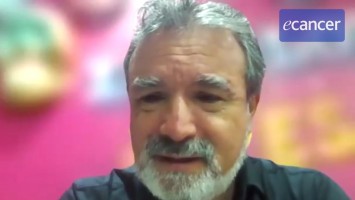IMPAKT Breast Cancer Conference 2013
Genetic alterations in postmenopausal women with hormone receptor-positive, HER2-negative advanced breast cancer
Prof Martine Piccart - Jules Bordet Institute, Brussels, Belgium
As you know, there has been an important clinical trial run for these patients comparing an aromatase inhibitor with or without an mTOR inhibitor. What has been done, in fact, is a very ambitious translational research programme on tumour samples from patients entered in this important study, performing next generation sequencing on these samples and identifying important mutations in key genes. What will be, of course, of great interest is to link these alterations to the clinical efficacy of the mTOR inhibitor because this treatment, obviously, is going to have a cost and it’s going to be important to understand who are the patients really benefitting. Now at this conference, IMPAKT, I presented just the description of the molecular alterations identified; the link between those and clinical outcome will be presented at the ASCO meeting.
What were some of the genetic alterations?
It was really very fascinating to see that close to 50% of the tumour samples showed aberrations in the gene mutation. So we know that this is the most frequently mutated gene but this is a very, very high incidence of mutations. In addition to that we discovered some very intriguing mutations in the ESR1 gene that is coding for the ER receptor. These mutations seem to cluster in the ligand binding domain of the oestrogen receptor and most probably are linked to the development of endocrine resistance. So there was also a suggestion from the study that we did that these mutations are more frequent in metastatic lesions as opposed to the primary tumour. So this appears to be a phenomenon that is happening along the evolution of the tumour. It’s an interesting discovery.
Which gene test have you found best for diagnosis?
What I think is that in the last 10-15 years there have been several multi-gene prognostic signatures developed and really I think they are very equivalent, as a matter of fact. They capture proliferation genes and give information on patient prognosis but that seems to be, of course, restricted to the luminal cancers. What is now becoming more evident at this conference is that some of these multi-gene signatures might be better than others in terms of predicting late relapses and that’s new information that is certainly interesting because you know that clinical trials are suggesting that luminal breast cancer is a chronic disease and that we should extend the duration of endocrine treatment, we should give more than five years, as a matter of fact probably ten years of adjuvant endocrine therapy but you also know that these treatments are not well tolerated by a substantial group of women. So it’s going to be interesting indeed using these tests to identify the group of women with an extremely low risk of late relapses to whom perhaps we will be able to say five years of adjuvant endocrine treatment is good enough for you.
What will the clinical implications be of genomic and proteomic assessments?
The implications of genomic and proteomic assessment of tumours is that they hopefully will bring us closer to personalised oncology. However, a conference like IMPAKT is clearly highlighting the fact that there is still a very long way to go. The more we look, the more complex things appear to be so the theme of the IMPAKT conference this year is about tumour heterogeneity and I must say that this is a little bit overwhelming for a clinician because you have the impression that this heterogeneity is absolutely huge and that it’s going to be very hard to identify a way to circumvent it. So we have a lot more to learn and, to me, it’s only through massive collaborative efforts that we will be able to become one day smarter than a cancer cell.
How many subtypes do you think there will eventually be?
Each time we look with a new technology we identify more. So I suspect that in a year from now we are going to hear that it’s 75-80. I really don’t know, I am hoping that somehow although they are many, many different diseases we will still be able to group some of them into a few categories because otherwise it’s going to be really hard to develop drugs for cancer patients.








